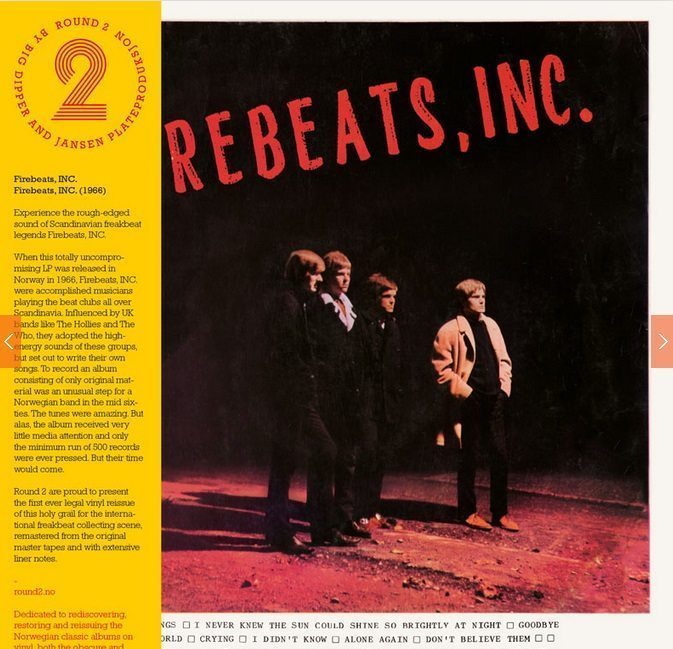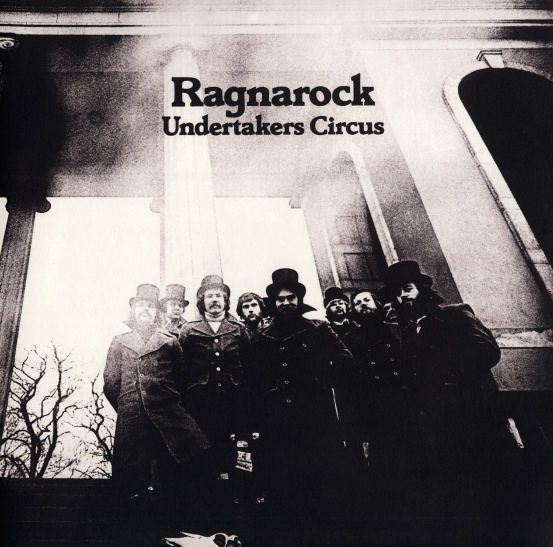[dropcap style=”font-size:100px; color:#992211;”]R[/dropcap]ound Two records, the vinyl imprint founded by Norwegian record shop Big Dipper, defines niche.
Thereupon, rare Scandinavian recordings are given a second chance to reach an audience via the medium of luxury vinyl pressings, replete with the lavish 180g discs, lovingly reprinted gatefold sleeves and exhaustive liner notes now expected by collectors. In some ways, the label’s releases are the vinyl enthusiast’s golden fleece – the albums are obscure, rare and of pristine quality.  Only the most curmudgeonly of trolls would argue that the allure of owning, say, an original Firebeats Inc. record (of which only five hundred were pressed) is now sullied by a re-edition of the album whose ownership no longer need be the result of an improbable crate-digging jackpot or a lengthy trawl through specialist online forums. Given that the Round Two reissues are clearly labelled as such, it’s unlikely that the rarity value of the originals will be in any way affected.
Only the most curmudgeonly of trolls would argue that the allure of owning, say, an original Firebeats Inc. record (of which only five hundred were pressed) is now sullied by a re-edition of the album whose ownership no longer need be the result of an improbable crate-digging jackpot or a lengthy trawl through specialist online forums. Given that the Round Two reissues are clearly labelled as such, it’s unlikely that the rarity value of the originals will be in any way affected.
Other releases on the imprint include, so far, albums by Undertakers’ Circus and Kare and the Cavemen What unites the otherwise diverse selection is a shared high standard of ensemble musicianship which reflects the live music circuit within Scandinavia during the period when the records were made.
Sleevenotes on both the Firebeats Inc. and Kare and the Cavemen records iterate the influence of extensive gigging on the respective bands’ musical fluidity and communication, the latter band having ridden a zeitgeist of interest in instrumental surf-guitar during the period immediately after the release of Tarantino’s Pulp Fiction, whilst Firebeats Inc. struggled to keep up with demand for their mid-sixties beat-pop at a point where local live music venues had not yet given way to the discotheque phenomenon.
To what extent the funk-rock fusion jams and Norwegian-language fantasy/mythic lyrics of the Undertakers’ Circus album Ragnarok rode any sort of popular zeitgeist is not made clear – Norse edda prog-fusion cosmic rock wig-outs likely being no more or less revered then than they are now – but it is still a blinder of a record, boasting musicianship of a standard rare outside of deservedly classic albums such as Astral Weeks or Abraxas.
Earliest of the three, the eponyous Firebeats Inc., opens with ‘Funny Things’. The initial ringing guitar lick sounds immediately recognisable as something Dave Davis might have put on a Kinks record, over a bass run which is a near-perfect snippet from The Who’s ‘My Generation’. The pattern repeats across the length of the record as aspects of the band’s sound refer directly to early sixties popular beat combos. Derivative? Certainly, but with enough blending of styles and original input to create something actually unique – a mosaic of sorts, bridging the various signature sounds of The Byrds, The Kinks and The Who to their own more louche approach which pre-empts certain rhythmic guitar/drums interplay of later groove rock.
That latter trope is most notable on the flagship of the album – ‘I Never Knew the Sun Could Shine So Brightly at Night’ – which locks a lightly-accented (‘I’ve been around/All the verlllld….’) vocal into a confident slouch-groove which could come straight out of Cream’s ‘Strange Brew’. In fact, given that Cream didn’t release that track until a year after Firebeats Inc., it’s possible that the creative juice flowed the opposite way. The subject matter – the midnight sun – could hardly be more Scandanavian.
Following track ‘Goodbye to this World’ somehow mingles Hotel California guitar with ‘Hang on Sloopy’, ‘Hey Carrie Anne’ and ‘La Bamba’. ‘Crying Over You’ is, musically, a cross between The Kinks’ ‘Party Line’ and The Beatles’ ‘I Feel Fine’, throwing a honkytonk piano bridge section into the mix so as to confound, once again, the accusation that this is a set of pastiche near-covers.
Repeated listens, from the surf-guitar/barbershop harmonies of ‘I Didn’t Know’, bringing to mind a cross between Gene Vincent and Eddie Cochran, to the Moody Blues-meets-Dusty Springfield heartache of ‘Alone Again’ confirm that the album is a lost gem of 1960s beat pop which, whilst evocative of numerous UK/US rivals, is as valid as its better-known contemporaries.
What Thor S. Greni is singing about on Ragnarok is, unless you happen to understand Norwegian, a bit of a guess. A certain amount can be guessed from the lyric sheet, if puzzling through Norse mythology references is your thing. A little research unveils the claim that the band were amongst the first Norwegian acts to introduce socio-political themes to their lyrics, and also that they set to music the poetry of working class poet/activist Rudolf Nilsen. The underworld mythology references are mirrored by a vocal treatment lurching between Rod Stewart rasp and proto doom metal grunter.
What is more notable than the vocal though, is the immense funk-soul-psych-afrobeat ensemble providing the groove, hovering between Earth, Wind and Fire, The Doobie Brothers and Santana, with occasional mis-hits evoking the Steve Miller Band. At times, the effect is competent pub-rock (mainly when the vocals become chanty ‘Life is Life’ stadium anthems), whilst at others, there are few pubs large enough to hold what sounds like a busload of smooth-groovin’ funk-cats filling the air with brass section, hand-percussion, overblown flute rills, smoky saxophone arabesques, bitchin’ rhythm guitar and generally jawdroppingly freaky Grateful Dead vibes. The band lineup featured no fewer than two trumpets, two trombones and a tenor sax, in addition to the standard rock complement.
It may well be that the vowel sounds of Norwegian inflect the vocals with a perceived flippancy which detracts from the outstanding interplay between the instrumental elements, but the passages of the record where the band plays (including a memorable flute/saxophone duel) extended solos and jams are the most satisfying, particularly on the tracks which deviate from 4/4 rhythm. Flute sections calling Ian Anderson to mind rub shoulders with Prince-tier funk guitar and smoky cop-movie tenor saxophone for long, lush passages on most tracks. The only real clangers are an ill-advised doo-wop novelty pastiche near the close of the album and a Bohemian Rhapsody-meets-Johnny B.Goode section to the final track (which is the funniest thing to come out of Scandanavia since the episode where Pingu’s dad gets drunk bottling up the homebrew). Groove, Ragnarok does, and then grooves some more.
On Jet Age, surf-rock quartet Kare and the Cavemen do exactly the one thing which would make Undertakers’ Circus perfect, in that they remove the vocal altogether and whip up a polished series of instrumentals evoking Dick Dale, Duane Eddy, Link Wray, and, unexpectedly, Kula Shaker. Again, the level of musicianship and technical prowess is notable, as if a group of seasoned session musicians came up with a series of inspired jams, then had Hank Marvin smooth out the rougher edges.
Two main strains of surf guitar filter through to Jet Age‘s sound. First of these is the B-movie swamp rock energy of ‘Mr Wild Guitar’ or ‘Hong Kong Cockfight’, mirroring the Bruce Brown movie-hall soundtracks of early-sixties Malibu, all single coil bridge-picking and whomping rhythms a la ‘Wipeout’ (or from the other theme of the era – hot rod street racing. ‘Rubber Street Revolution’ features hard-driving engine noise beneath its rumbling guitars.) If you could surf swamps (and the murky kegs of Kelly Slater’s inland wavepool suggest that you can do just that), this would be the music to do it to.
That aside, there are other strains of surf-movie sounds bubbling up from the grooves of the double album, showcasing particularly (amongst a cast of outstading musicians and engineers) the range of Knut Schreiner’s (later to helm Turbonegro) guitar skills. Mellow, Shadows-esque compositions mirror the change of style which overtook the California coast in the 1970s, as hair got longer and boards got shorter.  Morning of the Earth electric piano grooves, languid Dave Gilmour guitar solos and Latin conga rhythms suggest lazy evenings at Baja pointbreaks followed by mescal and Acapulco gold.
Morning of the Earth electric piano grooves, languid Dave Gilmour guitar solos and Latin conga rhythms suggest lazy evenings at Baja pointbreaks followed by mescal and Acapulco gold.
Moments of upifting jams on other tracks give strong reason to believe that the band spent time listening to Gary Hoey, bringing the surf-movie influences right up to 1994’s Endless Summer II. ‘Siamese Island’ strongly evokes The Sandals’ incidental music for the same film, as well as a theremin-ghosted tango in the Acker Bilk lounge orchestra style. Title track ‘Jet Age’ closes the album with a distinct musical nod to the choral crescendo of the Beach Boys’ ‘Surf’s Up’.
Jet Age, drawing seamlessly on influences from easy listening through psychedelia to progressive rock is almost the ideal vinyl album, in that it encapsulates so many of the motivations for buying the stuff in the first place. The sounds are lavish, the record is rare, the pressing is heavy and tactile, the effect cinematic and indulgent. Round Two’s reissue of the album is an inspired choice, and worthy of interest independent of the label’s stated focus on Scandanavian bands.
Sean Keenan used to write. Now he edits, and gets very annoyed about the word ‘ethereal’. Likely to bite anyone using the form ‘I’m loving….’. Don’t start him on the misuse of three-dot ellipses.
Divides his time between mid-Spain and South-West France, like one of those bucktoothed, fur-clad minor-aristocracy ogresses you see in Hello magazine, only without the naff chandeliers.
Twitter: @seaninspain





















